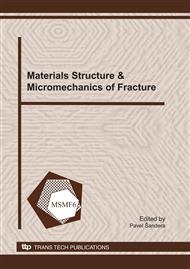p.97
p.101
p.105
p.111
p.115
p.119
p.123
p.129
p.133
3D Discrete Dislocation Modelling of High Temperature Plasticity
Abstract:
A 3D model is presented that addresses an evolution of flexible dislocation lines at high temperatures. The model is based on the linear theory of elasticity. A smooth dislocation line is approximated by a piecewise curve composed of short straight dislocation segments. Each dislocation segment is acted upon by a Peach-Koehler force due to a local stress field. All segment-segment interactions as well as an externally applied stress are considered. A segment mobility is proportional to the Peach-Koehler force, temperature-dependent factors control climb and glide motion of the segments. The potential of the model is demonstrated in simulations of simple high temperature processes including interactions of dislocations with secondary particles.
Info:
Periodical:
Pages:
115-118
Citation:
Online since:
January 2011
Authors:
Price:
Сopyright:
© 2011 Trans Tech Publications Ltd. All Rights Reserved
Share:
Citation:


